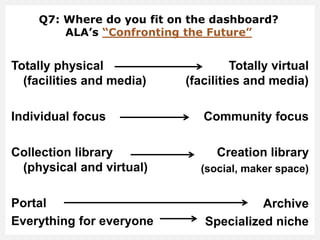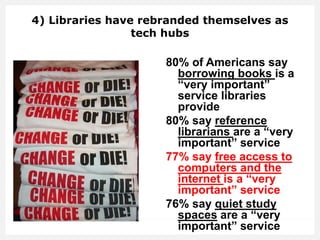The Future of Libraries
- 1. The Future of Libraries 7 Questions Librarians Need to Answer Lee Rainie Director – Pew Internet Project April 10, 2014 Texas Library Association @lrainie | @pewinternet | @pewresearch
- 2. 2 “Tweckle (twek’ul) vt. To abuse a speaker to Twitter followers in the audience while he/she is speaking.”
- 3. 3 we need a tshirt, "I survived the keynote disaster of 09" it's awesome in the "I don't want to turn away from the accident because I might see a severed head" way too bad they took my utensils away w/ my plate. I could have jammed the butter knife into my temple. http://bit.ly/124U9a4
- 5. The big questions 1. What’s the future of knowledge? 2. What’s the future of pathways to knowledge (reference expertise)? 3. What’s the future of public technology and community anchor institutions? 4. What’s the future of learning “spaces”? 5. What’s the future of attention (and its structural holes)? 6. What’s the franchise?
- 6. Q7: Where do you fit on the dashboard? ALA’s “Confronting the Future” Totally physical (facilities and media) Individual focus Collection library (physical and virtual) Portal Everything for everyone Totally virtual (facilities and media) Community focus Creation library (social, maker space) Archive Specialized niche
- 7. 5 big reasons your foundation is solid
- 8. 1) Libraries are appreciated 91% say libraries are important to their communities 76% say libraries are important to them and their families Robert Dawson photography - Library Road Trip http://www.robertdawson.com/pages/1/Public%20Library%3a%20An%20American%20Commons/Public%20Library%3a%2 0An%20American%20Commons/
- 9. If your local public library CLOSED, would that have a MAJOR impact, MINOR impact or NO IMPACT on … 29 63 38 27 32 7 0 20 40 60 80 100 You and your family Your community as a whole major impact minor impact no impact
- 11. 48 69 72 77 33 24 24 19 11 3 2 2 5 2 2 2 3 1 0 20 40 60 80 100 Public libraries provide many services people would have a hard time finding elsewhere. Having a public library improves the quality of life in a community. Because it provides free access to materials and resources, the public library plays an important role in giving everyone a… Public libraries are important because they promote literacy and a love of reading. Strongly agree somewhat agree Somewhat Disagree Strongly Disagree don’t know 96% 96% 93% 81%
- 12. 22 11 31 23 20 28 26 27 1 10 0 20 40 60 80 100 People do NOT need public libraries as much as they used to because they can find most information on their own. Public libraries have NOT done a good job keeping up with new technologies. Strongly agree somewhat agree Somewhat Disagree 34% 53% 55% 46%
- 13. 13 2) Libraries stack up well vs. others How confident? How important? 63 28 Library to community
- 14. 3) People like librarians 98% of “ever” library visitors say interactions are “very positive” 81% of library visitors say librarians are “very helpful” 50% of “last year” visitors got help from a librarian
- 15. 4) Libraries have rebranded themselves as tech hubs 80% of Americans say borrowing books is a “very important” service libraries provide 80% say reference librarians are a “very important” service 77% say free access to computers and the internet is a “very important” service 76% say quiet study spaces are a “very important” service
- 16. 5) Reading is alive and well 81% of those ages 16 and older read a book in the previous year, including 28% who read an e-book 13 is the mean/average number of books read in past 12 months and median/midpoint is 5 24 is mean/average for e-book readers 30% of e-content consumers are reading more now because e- content is available on new devices -- 41% for tablet owners 8% of those 16+ have borrowed an e-book from a library – and they are book buyers, too!
- 17. Now, back to the big questions 1. What’s the future of knowledge? 2. What’s the future of pathways to knowledge (reference expertise)? 3. What’s the future of public technology and community anchor institutions? 4. What’s the future of learning “spaces”? 5. What’s the future of attention (and its structural holes)? 6. What’s the franchise? 7. Where do you fit on the dashboard?
- 18. Q1: What is the future of knowledge?
- 19. • How is it created? New scientific method (and citizen scientists) … Big data … Niches and argument … Simulations and models • What are its interfaces? New displays … Networked data/info … Gamified environments • How is it disseminated? Social networks and media … Flipped schools … Learning as a process
- 20. Q2: What is the future of pathways to knowledge (reference expertise)?
- 21. • How do you search for information? Bigger, better search for everything … New interfaces …“Semantic web” … Bots … Predictive analytics • How do you aggregate / curate it? Key attribute of a helpful network “node” … “Do what you do best and link to the rest” • What new literacies are required to understand it? Searching … Evaluating … Pattern recognition and critical thinking … Coding and media production skills
- 22. Q3: What is the future of public technology and community anchor institutions?
- 23. • What ‘s the future of knowledge access points? Pervasive … Perpetual … Secure … On call • Where does local fit in? Huge for libraries • What divides persist / emerge? Access … competence … Quality of your network • What access models are enabled in new era of property / sharing? Subscription … Freemium … Platform for performance and discovery (local authors / creators) … Maker spaces
- 24. Q4: What is the future of learning spaces?
- 25. • What fosters collaboration? Creativity? Problem solving? In person … Electronically … Participatory … Experiential • What’s the future of literacy? New networking and technology skills • What is the role of solitude and quiet spaces? Help with personal balance • What allies can help you provide key information to your community? Social networking strategy for the institution
- 26. Q5: What is the future of attention?
- 27. • Multitasking • Deep diving • Snacking • What gaps can we fill? –Efficiencies we can offer in a world of changing abundance and scarcity –Personal needs – skills upgrading –Community needs –Time use
- 28. Q6: What’s the franchise? • What’s the commodity? Homework: The Innovators Dilemma The Innovators Solution Clayton Christensen, Michael Raynor
- 29. Examples of market and cultural shortcomings librarians are (and could) address 1) Technology non-users - skills training in new literacies 2) Pre-school programs 3) After school activities 4) English as a second language courses 5) Lifelong learning opportunities / credentialing competency 6) Fill gaps in local media ecosystem – community and civic information/curation 7) Help for small business / entrepreneurs / non- profits 8) Serendipity agents of discovery
- 30. 1 big PR problem that is not hard to fix
- 31. Answer the Marvin Gaye question • 22% say that they know all or most of the services their libraries offer • 46% say they know some of what their libraries offer • 31% said they know not much or nothing at all of what their libraries offer
- 32. What they want you to do
- 33. 82% 85% 14% 11% 3% 2% 0% 20% 40% 60% 80% 100% Should definitely do Should maybe do Should definitely not do Coordinate more closely with local schools in providing resources to kids Offer free early literacy programs to help young children prepare for school
- 34. 53% 59% 61% 30% 28% 27% 5% 9% 9% 0% 20% 40% 60% 80% 100% Should definitely do Should maybe do Should definitely not do More comfortable spaces for reading, working, relaxing Offer a broader selection of e-books Separate spaces for different services
- 35. 41% 42% 43% 47% 36% 34% 39% 38% 20% 19% 14% 12% 0% 20% 40% 60% 80% 100% Should definitely do Should maybe do Should definitely not do Offer more interactive learning experiences similar to museums Help users digitize material such as family photos / historical documents Move most library services online so users can access them without having to visit library Make most services automated, so people can find what they need and check out material on their own without help from staff
- 36. 18-29 yr olds, smartphone owners, know less about libraries, whites 20% 39% 36% Should definitely do Should maybe do Should definitely not do Move some print books and stacks out of public locations to free up more space for things such as tech centers, reading rooms, meetings rooms, and cultural events Less active library users, men, Af-Amer, Latinos, teens, less education, lower income HH, no computer Internet users, more active / knowledgeable patrons, whites, those over 50, higher income HH, full time workers, parents of tweens, computer owners, heavier book readers (including e-book readers)
- 37. What they say they’d use
- 38. 33% 34% 35% 35% 37% 30% 28% 34% 28% 36% 35% 36% 29% 35% 26% 0% 20% 40% 60% 80% 100% Very likely Somewhat likely Not too likely or not at all likely Cell app to use to access library services A tech “petting zoo” to try out new stuff Cell GPS app to navigate library Online research service – “ask a librarian” Kiosks (“Redbox”) around town for lib. checkouts
- 39. 23% 26% 26% 28% 29% 28% 32% 32% 29% 35% 48% 40% 39% 41% 34% 0% 20% 40% 60% 80% 100% Very likely Somewhat likely Not too likely or not at all likely Pre-loaded e-book readers Classes on how to download e-books Personalize, Amazon-style recommendations Digital media lab to digitize personal material Instruction on how to use e-reading devices
- 40. People
- 41. Place
- 42. Platform
- 43. Be not afraid
- 44. Libraries.pewinternet.org Lee Rainie Email: lrainie@pewinternet.org Twitter: @Lrainie Kathryn Zickuhr Email: kzickuhr@pewinternet.org Twitter: @kzickuhr Kristen Purcell Email: kpurcell@pewinternet.org Twitter: @kristenpurcell












































